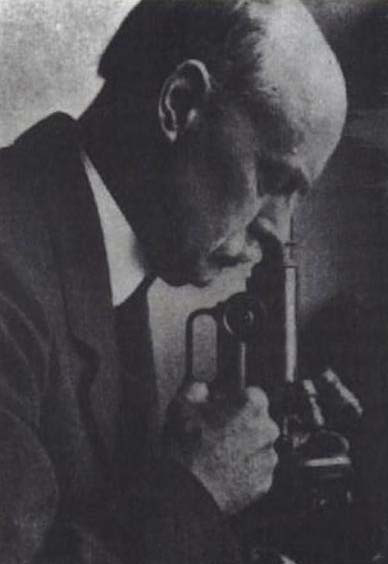Frank Burr Mallory

Frank Burr Mallory (1862–1941) was an American pathologist known for his contributions to medical research and education. He is best remembered for describing the Mallory body, a cellular inclusion found in the liver cells of people suffering from certain diseases, most notably alcoholic liver disease.
Early Life and Education[edit]
Frank Burr Mallory was born in 1862 in Cleveland, Ohio. He pursued his undergraduate education at Harvard University, where he developed an interest in medicine and pathology. After completing his undergraduate degree, Mallory went on to attend Harvard Medical School, where he graduated with his medical degree.
Career[edit]
After completing his medical education, Mallory began his career in pathology. He joined the faculty at Harvard Medical School, where he spent the majority of his professional life. Mallory was deeply involved in research, particularly in the study of liver diseases. His work in pathology led to significant advancements in the understanding of liver pathology and the effects of alcohol on the liver.
One of Mallory's most notable contributions to medicine was his description of the Mallory body, also known as Mallory-Denk bodies. These are abnormal collections of intermediate filaments and other proteins within liver cells. The presence of Mallory bodies is a characteristic feature of several liver conditions, including alcoholic liver disease, nonalcoholic steatohepatitis, and primary biliary cirrhosis.
In addition to his research on liver diseases, Mallory also made significant contributions to the understanding of infectious diseases. He was involved in the study of bacterial infections and the development of staining techniques that improved the visualization of bacteria under the microscope.
Legacy[edit]
Frank Burr Mallory's work had a lasting impact on the field of pathology. His research contributed to a better understanding of liver diseases and the development of diagnostic techniques that are still in use today. The Mallory body remains a key diagnostic feature in the pathology of liver disease.
Mallory was also a dedicated educator, teaching generations of medical students at Harvard Medical School. His contributions to medical education and research were recognized by his peers, and he is remembered as a pioneering figure in the field of pathology.
Death[edit]
Frank Burr Mallory passed away in 1941. His legacy continues through the ongoing study of liver diseases and the use of his staining techniques in pathology.
-
Frank Burr Mallory
-
Frank Burr Mallory (1862–1941) c. 1886
Ad. Transform your life with W8MD's Budget GLP-1 injections from $75


W8MD offers a medical weight loss program to lose weight in Philadelphia. Our physician-supervised medical weight loss provides:
- Weight loss injections in NYC (generic and brand names):
- Zepbound / Mounjaro, Wegovy / Ozempic, Saxenda
- Most insurances accepted or discounted self-pay rates. We will obtain insurance prior authorizations if needed.
- Generic GLP1 weight loss injections from $75 for the starting dose.
- Also offer prescription weight loss medications including Phentermine, Qsymia, Diethylpropion, Contrave etc.
NYC weight loss doctor appointmentsNYC weight loss doctor appointments
Start your NYC weight loss journey today at our NYC medical weight loss and Philadelphia medical weight loss clinics.
- Call 718-946-5500 to lose weight in NYC or for medical weight loss in Philadelphia 215-676-2334.
- Tags:NYC medical weight loss, Philadelphia lose weight Zepbound NYC, Budget GLP1 weight loss injections, Wegovy Philadelphia, Wegovy NYC, Philadelphia medical weight loss, Brookly weight loss and Wegovy NYC
|
WikiMD's Wellness Encyclopedia |
| Let Food Be Thy Medicine Medicine Thy Food - Hippocrates |
Medical Disclaimer: WikiMD is not a substitute for professional medical advice. The information on WikiMD is provided as an information resource only, may be incorrect, outdated or misleading, and is not to be used or relied on for any diagnostic or treatment purposes. Please consult your health care provider before making any healthcare decisions or for guidance about a specific medical condition. WikiMD expressly disclaims responsibility, and shall have no liability, for any damages, loss, injury, or liability whatsoever suffered as a result of your reliance on the information contained in this site. By visiting this site you agree to the foregoing terms and conditions, which may from time to time be changed or supplemented by WikiMD. If you do not agree to the foregoing terms and conditions, you should not enter or use this site. See full disclaimer.
Credits:Most images are courtesy of Wikimedia commons, and templates, categories Wikipedia, licensed under CC BY SA or similar.
Translate this page: - East Asian
中文,
日本,
한국어,
South Asian
हिन्दी,
தமிழ்,
తెలుగు,
Urdu,
ಕನ್ನಡ,
Southeast Asian
Indonesian,
Vietnamese,
Thai,
မြန်မာဘာသာ,
বাংলা
European
español,
Deutsch,
français,
Greek,
português do Brasil,
polski,
română,
русский,
Nederlands,
norsk,
svenska,
suomi,
Italian
Middle Eastern & African
عربى,
Turkish,
Persian,
Hebrew,
Afrikaans,
isiZulu,
Kiswahili,
Other
Bulgarian,
Hungarian,
Czech,
Swedish,
മലയാളം,
मराठी,
ਪੰਜਾਬੀ,
ગુજરાતી,
Portuguese,
Ukrainian


